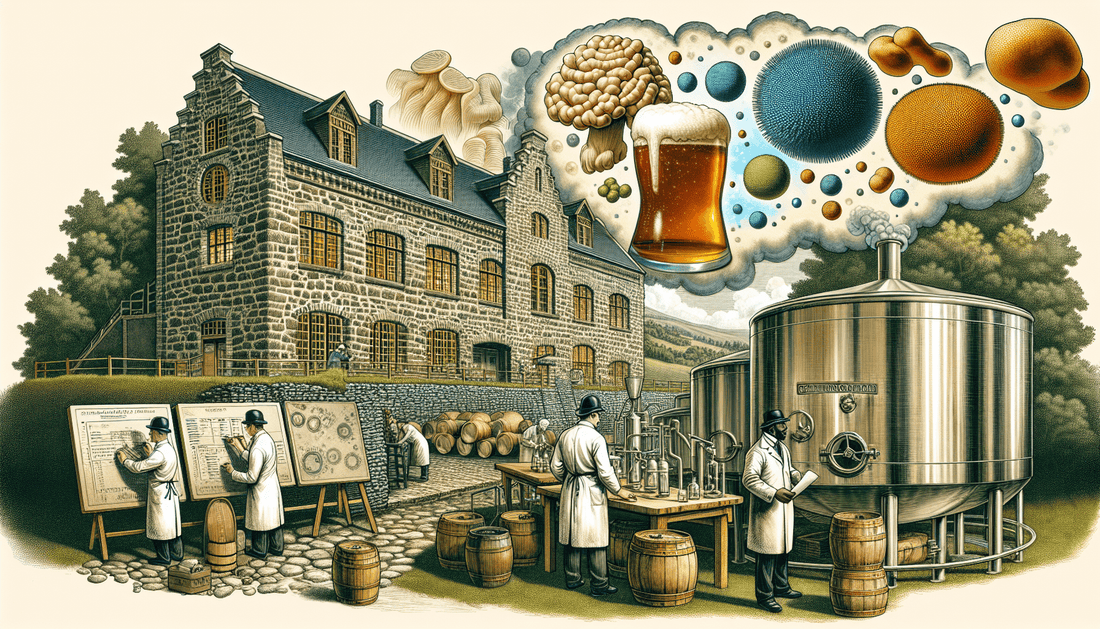How the Carlsberg Laboratory Changed the World

In this blog we delve into the fascinating history of Carlsberg and the impact their laboratory has had on microbiology and modern medicine. Discover how two men's search for the cause of sour beer changed the world and further revealed the meaning of beer to humanity.
🌍 The World of Beer and Its Importance
Beer is much more than just a thirst quencher; it is an integral part of various cultures and societies around the world. It has influenced humanity throughout the ages, from ancient civilizations to modern times. Beer was not just a drink, but a symbol of community, tradition and innovation.
The role of beer in society is deeply rooted. It served as a source of nutrition, especially in times of scarcity. In many cultures, beer was even used as a form of currency. The production of beer has led to technological innovations such as the development of agricultural techniques and the creation of laboratories that made microbiological research possible.
- Cultural Impact: Beer connects people and creates communities, whether it's a local brewery or an international beer festival.
- Economic Contribution: The beer industry generates billions of euros in revenue and provides millions of jobs worldwide.
- Scientific Advances: Research into beer has led to important discoveries in microbiology and biotechnology.
🏛️ The Origin of Carlsberg
Founded by JC Jacobsen in 1847, Carlsberg is one of the most iconic breweries in the world. The name 'Carlsberg' is derived from the hill where the brewery is located, and it is a tribute to his son, Carl. This was a time when demand for lager beer was increasing, and Jacobsen was determined to produce the best quality beer possible.
Jacobsen started experimenting with different brewing techniques and ingredients. He was inspired by his travels to Germany, where he learned the secrets of lager brewing. The founding of Carlsberg marked the beginning of a new era in beer production, with a focus on science and quality.
Carlsberg's laboratory quickly became a center for research, where scientists studied the microbiology of beer. This led to innovations that revolutionized the brewing industry.
👨👦 The Relationship Between JC Jacobsen and His Son Carl
The relationship between JC Jacobsen and his son Carl was complex and full of challenges. While JC was a passionate and driven entrepreneur, he had high expectations for his son. He wanted Carl to take charge of Carlsberg, but their views on brewing differed significantly.
JC was traditional and feared that Carl's modern approaches would damage the quality of the beer. This led to tensions that put a strain on their relationship. Carl often felt deprived and pressured by his father, which resulted in a struggle for control of Carlsberg's future.
The dynamic between father and son illustrates the challenges of family relationships in a business context, especially when passion and ambition are at stake.
⚔️ The Conflict Between Father and Son
The conflict between JC and Carl came to a head when Carl decided to open a new brewery called New Carlsberg. This was not only a business move, but also an act of independence. Carl wanted to brew his own vision of beer, free from the restrictions imposed by his father.
It was a bitter conflict that led to a public rivalry between the two breweries. In fact, the rivalry became so intense that they attacked each other in advertisements and on social media. This story of competition and conflict reflects not only the challenges within a family business, but also the passion and desire for innovation in the brewing industry.
Ultimately, their battle led to a divorce that would last decades, only restored on JC's deathbed. This emphasizes the tragic side of their relationship, which was overshadowed by business interests.
🔬 Emil Christian Hansen: The Man Behind the Discovery
Emil Christian Hansen played a crucial role in Carlsberg's scientific progress. He was a brilliant microbiologist responsible for the discovery of several yeast strains essential for the production of quality beer. His work helped put the Carlsberg laboratory on the map as a center for microbiological research.
Hansen's discovery that yeast comes in different strains changed the way beer was brewed. Previously it was believed that there was only one type of yeast, but his research showed that different yeasts can impart different flavors and properties to beer.
His innovations led to the development of a pure yeast that improved the brewing process and took the quality of the beer to a higher level. This not only affected Carlsberg, but the entire beer industry worldwide.
Through his dedication to scientific research and innovation, Hansen has had a lasting impact on the way we understand and produce beer. His work remains relevant in the world of brewing to this day.
🔬 The Carlsberg Laboratory: A Scientific Revolution
The Carlsberg Laboratory is more than just a research facility; it is the cradle of scientific revolutions in microbiology. Founded by JC Jacobsen, the laboratory reflected his passion for science and quality. It was a place where the secrets of yeast and fermentation were unraveled, with the aim of improving beer production.
Under the leadership of brilliant scientists such as Emil Christian Hansen, the laboratory became a center for innovation. The discoveries made here not only changed the beer industry, but also influenced other sectors such as medicine and agriculture.
The laboratory was a pioneer in the use of microbiological techniques to ensure the quality of beer. This led to the development of new brewing methods and the isolation of different yeast strains, which revolutionized the way beer was produced.
🌱 Innovations and Discoveries
- Isolation of Yeast: The laboratory was the first to isolate different yeast strains, which laid the foundation for quality beer.
- Scientific Collaboration: It attracted scientists from all over the world, leading to collaborations that pushed microbiology forward.
- Education and Public Access: Jacobsen believed in sharing knowledge, making discoveries accessible to the broader community.
🍺 The Discovery of Different Yeast Strains
The discovery of different yeast strains was a turning point in the history of the brewery. Previously it was believed that only one species of yeast existed, but Hansen's work revealed a wealth of varieties. These varieties affect not only the taste, but also the quality and shelf life of beer.
Hansen's methods of isolating and reproducing yeast strains were revolutionary. Through his work, brewers could now choose which yeast best suited their beer recipe. This led to a huge diversification of beer styles, from light lagers to rich ales.
The impact of these discoveries extends beyond just beer. The techniques developed for yeast isolation are now being applied in other industries, such as the production of biofuels and pharmaceuticals.
🔍 The Uses of Yeast
- Brewery: Different types of yeast are used for different beer styles, leading to unique flavors and aromas.
- Medicine: Yeast is used in the production of vaccines and medicines, including insulin.
- Biofuels: Biotechnology uses yeast to produce sustainable energy sources.
🏭 Impact on the Food and Medicine Industry
The Carlsberg Laboratory's impact extends to the food and medicine industries. The discoveries of yeast strains have not only changed beer production, but also the way food is produced and stored. Fermentation processes are crucial for the production of various foods such as bread, cheese and yogurt.
In medicine, the use of yeast has led to significant advances. The production of insulin, crucial for diabetics, is one of the most impressive applications of yeast technology. This allows millions of people worldwide to receive better treatment.
In addition, the knowledge gained in the Carlsberg Laboratory has contributed to the understanding of microbial fermentation, which is essential for developing new methods in food safety and processing.
🥗 Progress in Food Production
- Fermentation: The techniques developed in the laboratory have been applied to various fermentation processes, which has improved food quality.
- Food Safety: Yeast research has led to better methods for combating food spoilage bacteria.
- Innovation in Product Development: New products have been created by combining yeast technology with other foods.
🏅 The Legacy of the Carlsberg Laboratory
The legacy of the Carlsberg Laboratory is unmistakable. It not only changed the beer industry, but also had a lasting impact on science and medicine. The discoveries made here remain relevant and inspire generations of scientists and brewers.
The laboratory serves as a symbol of innovation and collaboration. The idea that knowledge should be shared has led to a culture of openness that promotes scientific research. The impact of this approach is felt in various sectors around the world.
Today, the Carlsberg Laboratory remains a center for research and development, where new ideas are born and existing knowledge is expanded. It is a testament to the power of science and the role it plays in our daily lives.
📚 A Look into the Future
- Research and Innovation: The laboratory continues to focus on new discoveries and innovations in brewing technology.
- Education: It provides opportunities for students and researchers to learn and contribute to science.
- Sustainability: New techniques are developed to reduce the brewery's impact on the environment.
The future of the Carlsberg Laboratory is promising, with continued efforts to push the boundaries of what is possible in microbiology.





